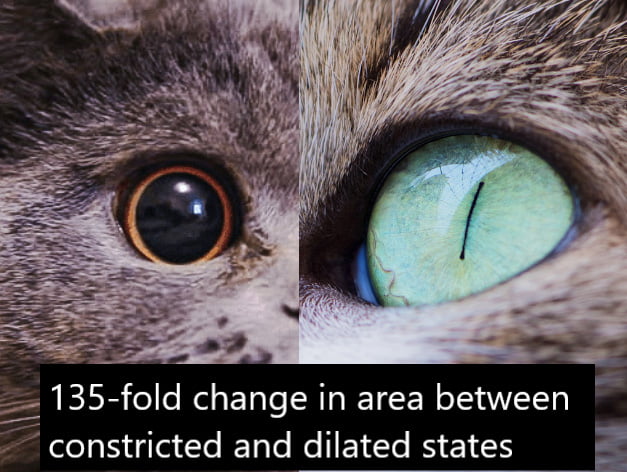People ask “Why do domestic cats have slitted eyes?” The reasons are (a) they can use the closing of the eyelid to reduce even further the light entering the eye beyond simply closing the aperture of the pupil and (b) to maximise blur behind and in front of the object focused upon to improve horizontal distances and make hunting more efficient and to improve stereoscopic vision.

A – If you envisage the cat’s eyelid coming down over the closed slit of the cat’s pupil you can see how the amount of light entering the eye and impinging on the retina is reduced even further than by simply closing the pupil. The cat needs this facility as their eyes are super sensitive to see at night. Bright sunlight might damage eyes but for the eyelid passing down over the slit-like iris like a blind being drawn down over a window.

RELATED: there is a third reason 😎. Reducing the pupil size using a slit compared to a circle provides a 135-fold change in area of the pupil between constricted and dilated states which allows the eye to control the amount of light impacting the retina under a much wider range of light and brightness conditions which is essential for the domestic cat to improve hunting ability. CLICK THIS LINK TO SEE ANOTHER PAGE ON THIS TOPIC.
The reason why domestic cat eyes are super-sensitive to light is because there is a reflective layer behind the retina which reflects light back into the retina from the other side of it. The reflective layer is called the ‘tapetum lucidum’. In the words of PubMed: “light-sensitive retinal cells with a second opportunity for photon-photoreceptor stimulation, thereby enhancing visual sensitivity at low light levels.”
The domestic cat’s wild cat ancestor, the North African wild cat (aka African-Asian wildcat), exclusively hunts at night and the domestic cat has inherited the eyes of this wild cat although the domestic cat has evolved to hunt at any time but primarily at dawn and dusk. Dr Morris says that lion’s circular pupil is evidence of the fact that the lion is primarily a daytime hunter and therefore their eyes are less sensitive to light. Although the lion does also hunt at night also (Sunquist 2002).
B – Martin Banks at the University of California (on livescience.com) did some research on this. He believes that the slitted pupil allows better judgement of horizontal distances because it maximises the blur behind and in front of the target object upon which the eye is focused. The vertical slit also maximises stereoscopic vision he says. Both these aspects of the cat’s vision assist in catching prey by permitting better depth judgement and accurate targeting. This is another reason why the domestic cat is such a fabulous hunter. An animal designed to hunt and survive. Everything to do with the domestic cat is built around that.
Can the human eye resolve detail better than the cat’s eye?
Some more information about the cat eye. A study (“Optical quality of the living cat eye”) published in 1974 concluded that the optical resolution of the cat eye is 3-5 times poorer than that of the human eye. Another study called “Optical quality of the cat eye” published early in 1971 concluded: “The optical quality of the human eye is better than that of the cat’s eye.”
Below are some more pages on feline eyes.

